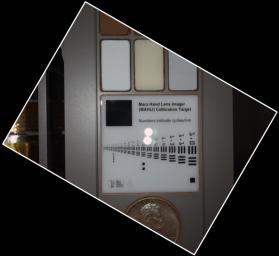
|
Calibration Target as Seen by Mars Hand Lens Imager
- Click the image above for a larger view
- Full-Res JPEG (2028 x 1864) (248.1 kB)
- Full-Res TIFF (2028 x 1864) (11.4 MB)
Caption:
During pre-flight testing, the Mars Hand Lens Imager (MAHLI) camera on NASA's Mars rover Curiosity took this image of the MAHLI calibration target from a distance of 3.94 inches (10 centimeters) away from the target.
The MAHLI adjustable-focus, color camera is one of the tools on the turret at the end of Curiosity's robotic arm. Its calibration target is attached to the rover at the arm's shoulder joint.
This image shows reflections of MAHLI's white-light LEDs (light emitting diodes) off the opal glass of the bar target. It can be compared with image PIA15288 which was taken when the white LEDs were off and the instrument's ultraviolet LEDs were on.
The target's bar graphic is adapted from a standardized U.S. Air Force chart for testing camera resolution. Numbers on it refer to how many of the black-white cycles fit into one millimeter. For example, in the largest set of bars, labeled 1.0, each black bar is one-half millimeter wide and each white space between bars is another one-half millimeter. One millimeter is about 0.04 inch. Applied Image Inc., Rochester, N.Y., made the portion of the MAHLI calibration target with this chart and other graphics on opal glass. One of the graphics, just above the left edge of the penny, is a tiny cartoon figure called "Joe the Martian."
The row of three pigmented swatches just above the bar graphic provides references of 40-percent gray (left), fluorescent pigment, and 60-percent gray. The row above that, only partial visible in this image, provides red, green and blue color references.
Including a Lincoln penny on the calibration target is a nod to geologists' tradition of placing a coin as a size reference in close-up photographs of rocks. It gives the public a familiar object for perceiving size easily.
NASA's Mars Science Laboratory mission launched on Nov. 26, 2011, and will deliver the rover Curiosity to Gale Crater on Mars in August 2012. With MAHLI and nine other science instruments, Curiosity will investigate whether the area has ever offered environmental conditions favorable for microbial life.
Background Info:
Malin Space Science Systems, San Diego, supplied MAHLI and three other cameras for the mission. NASA's Jet Propulsion Laboratory, a division of the California Institute of Technology, in Pasadena, manages the Mars Science Laboratory mission for the NASA Science Mission Directorate, Washington, and built Curiosity.
Cataloging Keywords:
| Name | Value | Additional Values |
|---|---|---|
| Target | Mars | |
| System | ||
| Target Type | Planet | |
| Mission | Mars Science Laboratory (MSL) | |
| Instrument Host | Curiosity Rover | |
| Host Type | Rover | |
| Instrument | Mars Hand Lens Imager (MAHLI) | |
| Detector | ||
| Extra Keywords | Color, Crater, Ultraviolet | |
| Acquisition Date | ||
| Release Date | 2012-02-07 | |
| Date in Caption | 2011-11-26 | |
| Image Credit | NASA/JPL-Caltech/Malin Space Science Systems | |
| Source | photojournal.jpl.nasa.gov/catalog/PIA15287 | |
| Identifier | PIA15287 | |
